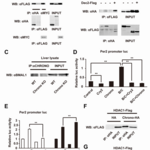Genetics & Molecular Biology

Biomedical engineers at Columbia Engineering have successfully grown fully functional human cartilage in vitro from human stem cells derived from adult stem cells in bone marrow tissue.
Some researchers call cartilage the "official tissue of tissue engineering". Many groups have studied cartilage as an apparently simple tissue: one single cell type, no blood vessels or nerves, a tissue built for bearing loads while protecting bone ends in the joints.
While there has been great success in engineering pieces of cartilage using young animal cells, no one has, until now, been able to…

The genomics revolution has been going on for decades, but half of known eukaryote lineages remain unstudied at the genomic level.
A new survey, with results published in
of Trends in Ecology and Evolution, concludes that this is simply a popularity contest and the field is displaying research bias against 'less popular', but potentially genetically rich, single-cell organisms. The lack of microbial representation leaves a world of untapped genetic potential undiscovered.
The authors call for a broader, objective and species relationship-based initiative to sequence microbial eukaryotic…

While our chromosomes are relatively stable within our lifetimes, the genetic material found in our mitochondria is highly variable across individuals and may impact upon human health, say researchers at the University of Montreal and its affiliated CHU Sainte-Justine Hospital.
Genomes are changing, they say, not just from generation to generation, but even and in fact within our individual cells. The researchers are the first to identify the extent to which the editing processes of RNA code can vary across a large number of individuals.
"Mitochondria are the power stations of our cells,…

Some
genetic diseases caused by an abnormal repeat in the DNA are known to become
more severe with each new generation - this dreadful trait is called anticipation.
Now a study by Portuguese researchers from Porto University has proved for the first time the existence of anticipation
in diseases caused by a different type of errors that not a DNA repeat, in this case in the fatal neurodegenerative
disorder Familial Amyloid Polyneuropathy
(FAP).
The discovery has two major implications:
first it opens the door to the possibility that many more diseases could show
anticipation, including…

Chronic pain is an unknown issue with unknown causes and a subjective definition but some people clearly have it. Researchers recently analyzed 2,721 people, all taking prescription opioid pain medications, for genes COMT, DRD2, DRD1 and OPRK1. The participants also rated their perception of pain on a scale from zero to 10. People who rated their pain as zero were not included in the study.
Low pain perception was defined as a score of one, two or three; moderate pain perception was a score of four, five or six; and high pain perception was a score of seven, eight, nine or 10.
9…

In biology, anticipation is the term for genetic diseases caused by an abnormal repeat in DNA that becomes more severe with each new generation.
Now there is a twist. A study has found the existence of anticipation in diseases caused by different errors - not a DNA repeat - in fatal neurodegenerative disorder Familial Amyloid Polyneuropathy (FAP).
Familial Amyloid Polyneuropathy
is a progressive and fatal neurodegenerative (where neurons die) disorder still without a cure or a clear mechanism. Like in many age-related neurodegenerative disorders including Alzheimer’s and Parkinson’s,…

All organisms, from mammals to fungi, have daily cycles controlled by a tightly regulated internal clock called the circadian clock.
The circadian clock is influenced by exposure to light and dictates the wake-sleep cycle. At the cellular level, the clock is controlled by a complex network of genes and proteins that switch each other on and off based on cues from their environment and most genes involved in the regulation of the circadian clock have been characterized, but a key component was missing in mammals.
In a new study, a team performed a genome-wide chromatin…

Cardiovascular disease often causes the heart to work harder than usual,
a condition that triggers the chronic buildup of cardiac pressure and the onset
of heart failure.
A new study now shows that microRNA-25 is a new molecular
switch that is activated in the overworked heart to drive the onset of heart
failure.
Heart failure is the progressive decline
in heart’s contractile function, and is commonly caused by a number of
cardiovascular diseases including hypertension, atherosclerosis, and many
others1. These cardiovascular conditions hinder cardiac function,
and can cause the heart to…

A genetic study of brown bears (Ursus arctos) in Bulgarian mountain regions showed they originated in Carpathia. So how did they get to Bulgaria? It wasn't natural dispersal.
Bulgarian and Romanian NGOs, the Frankfurt Zoological Society, and scientists of the Senckenberg Conservation Genetics Section in Frankfurt have found that a legend was probably true - the legend being that the former leader of the Romanian Communist Party, Nicolae Ceausescu, flew the bears to Bulgaria.
The brown bear (Ursus arctos) is an endangered species across Europe and largely extinct in the western part of…

Some long non-coding RNAs can give rise to small proteins that have biological functions, according to a recent study that describes how researchers have used ribosome profiling to identify several hundred long non-coding RNAs that may give rise to small peptides.
Not so long ago researchers thought that RNAs came in two types: coding RNAs that make proteins and non-coding RNAs that have structural roles. Then came the discovery of small RNAs that opened up whole new areas of research. Now researchers have come full circle and predicted that some long non-coding RNAs can give rise to small…